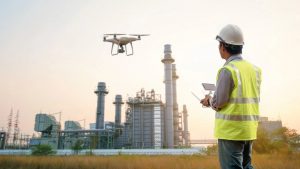 The rapid advancement of drone technology has revolutionized various industries, and site security is no exception. Drone-based security systems offer unparalleled advantages in monitoring, surveillance, and threat detection, making them an invaluable asset for safeguarding industrial, commercial, and construction sites. By enhancing safety, boosting productivity, and improving operational efficiency, drones are redefining the future of site security. This article explores the key benefits, applications, and innovations in drone-based site security.
The rapid advancement of drone technology has revolutionized various industries, and site security is no exception. Drone-based security systems offer unparalleled advantages in monitoring, surveillance, and threat detection, making them an invaluable asset for safeguarding industrial, commercial, and construction sites. By enhancing safety, boosting productivity, and improving operational efficiency, drones are redefining the future of site security. This article explores the key benefits, applications, and innovations in drone-based site security.
The Role of Drones in Site Security
Drones equipped with high-resolution cameras, thermal imaging sensors, and real-time communication capabilities provide a proactive approach to site security. Their ability to monitor large areas quickly and effectively makes them ideal for protecting sensitive or high-risk locations. Key features of drone-based security include:
- Aerial Surveillance: Comprehensive coverage of expansive areas from the sky.
- Real-Time Data Transmission: Instant communication of visual and sensor data to security teams.
- Autonomous Patrolling: Pre-programmed flight paths for routine monitoring.
- Rapid Response: Quick deployment to investigate alerts or suspicious activities.
Enhancing Safety
- Threat Detection and Deterrence
Drones serve as a visible deterrent to potential intruders and provide advanced threat detection capabilities. Equipped with infrared cameras and motion sensors, drones can identify unauthorized access or unusual activities even in low-visibility conditions.
- Hazard Monitoring
In construction and industrial sites, drones can monitor hazardous areas, reducing the risk to human personnel. By identifying safety risks such as equipment malfunctions, structural issues, or fire hazards, drones contribute to a safer working environment.
- Emergency Response
Drones can provide real-time situational awareness during emergencies, such as fires, accidents, or natural disasters. Their ability to navigate challenging environments allows responders to assess risks and coordinate rescue operations efficiently.
Boosting Productivity
- Reduced Downtime
By providing 24/7 monitoring and rapid incident detection, drones help minimize downtime caused by security breaches or operational disruptions. Continuous surveillance ensures that operations run smoothly.
- Optimized Resource Allocation
Drones reduce the need for extensive manpower in routine security tasks. Security personnel can focus on strategic decision-making and response planning, improving overall productivity.
- Efficient Inspections
Drones can conduct routine inspections of equipment, infrastructure, and perimeter boundaries more quickly and accurately than traditional methods. This efficiency saves time and prevents delays in project timelines.
Improving Efficiency
- Cost-Effective Solutions
While the initial investment in drone technology may be significant, the long-term savings in manpower, equipment maintenance, and incident mitigation make drones a cost-effective solution for site security.
- Advanced Analytics
Drones equipped with AI and machine learning algorithms can analyze patterns, detect anomalies, and provide actionable insights. These capabilities enhance decision-making and streamline security operations.
- Scalability
Drone-based security systems are highly scalable, making them suitable for various site sizes and complexities. Whether for small commercial properties or sprawling industrial facilities, drones can adapt to diverse security needs.
Applications of Drone-Based Site Security
- Construction Sites
Drones monitor construction sites to prevent theft, vandalism, and unauthorized access. They also ensure compliance with safety regulations by identifying hazards and documenting progress.
- Industrial Facilities
In industrial settings, drones safeguard critical infrastructure, such as power plants, oil refineries, and warehouses. Their ability to detect leaks, overheating, or other anomalies ensures operational continuity and safety.
- Commercial Properties
For commercial properties, drones provide perimeter surveillance, parking lot monitoring, and crowd management. They enhance customer safety and protect valuable assets.
- Remote Locations
In remote or hard-to-reach areas, drones offer reliable security coverage. They reduce the need for on-site personnel and ensure consistent monitoring.
- Perimeter Security
 Perimeter security drones provide a cutting-edge solution for real-time monitoring and protection of sensitive locations. Utilizing autonomous flight technology and aerial surveillance capabilities, these drones enhance security through constant surveillance and rapid response to threats. Whether tethered or free-flying, perimeter security drones deliver advanced monitoring for commercial, defense, infrastructure, and critical facilities, making them a crucial asset in modern-day location security.
Perimeter security drones provide a cutting-edge solution for real-time monitoring and protection of sensitive locations. Utilizing autonomous flight technology and aerial surveillance capabilities, these drones enhance security through constant surveillance and rapid response to threats. Whether tethered or free-flying, perimeter security drones deliver advanced monitoring for commercial, defense, infrastructure, and critical facilities, making them a crucial asset in modern-day location security.
Challenges and Considerations
- Regulatory Compliance
Drone operations are subject to aviation regulations and privacy laws. Organizations must ensure compliance with local and international guidelines to avoid legal complications.
- Technical Limitations
Factors such as battery life, weather conditions, and payload capacity can impact drone performance. Continuous advancements in technology are addressing these limitations.
- Data Security
The transmission and storage of sensitive data collected by drones require robust cybersecurity measures. Protecting this data from breaches is critical for maintaining trust and operational integrity.
- Training and Expertise
Effective implementation of drone-based security systems requires trained operators and technicians. Investing in education and skill development is essential for maximizing the technology’s potential.
Future Trends in Drone-Based Security
- AI and Automation
The integration of artificial intelligence enables drones to autonomously detect threats, predict risks, and adapt to changing conditions. AI-powered analytics enhance the overall efficiency of security systems.
- Swarm Technology
Swarm technology involves the coordinated operation of multiple drones for large-scale surveillance and response. This approach is particularly useful for expansive industrial sites or emergency scenarios.
- Advanced Sensors
Innovations in sensor technology, such as multispectral imaging and environmental monitoring, are expanding the capabilities of drones. These advancements enable more comprehensive and precise security coverage.























































